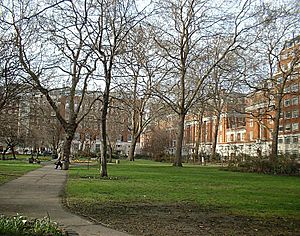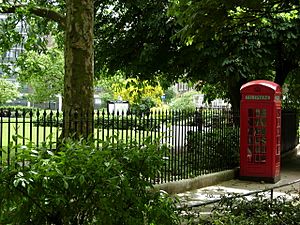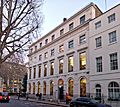Bloomsbury facts for kids
Quick facts for kids Bloomsbury |
|
|---|---|
|
Top to right: British Museum; Bedford Square, Cartwright Gardens; Sicilian Avenue; Gordon Square
|
|
| Population | 10,892 (2011 Census. Ward) |
| OS grid reference | TQ299818 |
| London borough | |
| Ceremonial county | Greater London |
| Region | |
| Country | England |
| Sovereign state | United Kingdom |
| Post town | LONDON |
| Postcode district | WC1, NW1 |
| Dialling code | 020 |
| Police | Metropolitan |
| Fire | London |
| Ambulance | London |
| EU Parliament | London |
| UK Parliament |
|
| London Assembly |
|
Bloomsbury is a district in the West End of London. It is considered a fashionable residential area, and is the location of numerous cultural, intellectual, and educational institutions.
Bloomsbury is home of the British Museum, the largest museum in the United Kingdom, and several educational institutions, including University College London and a number of other colleges and institutes of the University of London as well as its central headquarters, the New College of the Humanities, the University of Law, the Royal Academy of Dramatic Art, the British Medical Association and many others. Bloomsbury is an intellectual and literary hub for London, as home of world-known Bloomsbury Publishing, publishers of the Harry Potter series, and namesake of the Bloomsbury Set, a group of British intellectuals which included author Virginia Woolf, biographer Lytton Strachey, and economist John Maynard Keynes.
Bloomsbury began to be developed in the 17th century under the Earls of Southampton, but it was primarily in the 19th century, under the Duke of Bedford, that the district was planned and built as an affluent Regency era residential area by famed developer James Burton. The district is known for its numerous garden squares, including Bloomsbury Square, Russell Square and Bedford Square.
Bloomsbury's built heritage is currently protected by the designation of a conservation area and a locally based conservation committee. Despite this, there is increasing concern about a trend towards larger and less sensitive development, and the associated demolition of Victorian and Georgian buildings.
Contents
History
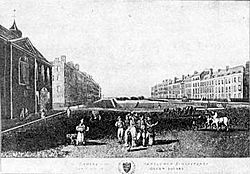
The earliest record of what would become Bloomsbury is in the 1086 Domesday Book, which states that the area had vineyards and "wood for 100 pigs". But it is not until 1201 that the name Bloomsbury is first noted, when William de Blemond, a Norman landowner, acquired the land. The name Bloomsbury is a development from Blemondisberi – the bury, or manor, of Blemond. An 1878 publication, Old and New London: Volume 4, mentions the idea that the area was named after a village called "Lomesbury" which formerly stood where Bloomsbury Square is now, though this etymology is now discredited.
At the end of the 14th century, Edward III acquired Blemond's manor, and passed it on to the Carthusian monks of the London Charterhouse, who kept the area mostly rural.
In the 16th century with the Dissolution of the Monasteries, Henry VIII took the land back into the possession of the Crown and granted it to Thomas Wriothesley, 1st Earl of Southampton.
In the early 1660s, the Earl of Southampton constructed what eventually became Bloomsbury Square. The Yorkshire Grey public house on the corner of Gray's Inn Road and Theobald's Road dates from 1676. The area was laid out mainly in the 18th century, largely by landowners such as Wriothesley Russell, 3rd Duke of Bedford, who built Bloomsbury Market, which opened in 1730. The major development of the squares that we see today started in about 1800 when Francis Russell, 5th Duke of Bedford removed Bedford House and developed the land to the north with Russell Square as its centrepiece.
Geography
Bloomsbury has no official boundaries, but can be roughly defined as the square of territory bounded by Tottenham Court Road to the west, Euston Road to the north, Gray's Inn Road to the east, and either High Holborn or the thoroughfare formed by New Oxford Street, Bloomsbury Way and Theobalds Road to the south. Bloomsbury merges gradually with Holborn in the south, with St Pancras and King's Cross in the north-east and with Clerkenwell in the south-east.
The area is bisected north to south by the main road Southampton Row/Woburn Place, which has several large tourist hotels and links Tavistock Square and Russell Square – the central points of Bloomsbury. The road runs from Euston and Somers Town in the north to Holborn in the south.
East of Southampton Row/Woburn Place are the Grade II listed Brunswick Centre, a residential and shopping centre, and Coram's Fields children's recreation area. The area to the north of Coram's Fields consists mainly of blocks of flats, built as both private and social housing, which is often considered part of St Pancras or King's Cross rather than north-eastern Bloomsbury. The area to the south is generally less residential, containing several hospitals, including Great Ormond Street, and gradually becomes more commercial in character as it approaches Holborn at Theobald's Road.
The area west of Southampton Row/Woburn Place is notable for its concentration of academic establishments, museums, and formal squares. Here are the British Museum and the central departments and colleges of the University of London, including Birkbeck College, University College London, the School of Oriental and African Studies, and the University of London's School of Advanced Study. The main north-south road in west Bloomsbury is Gower Street which is a one-way street running south from Euston Road towards Shaftesbury Avenue in Covent Garden, becoming Bloomsbury Street when it passes to the west of the British Museum.
Parks and squares
Bloomsbury contains some of London's finest parks and buildings, and is particularly known for its formal squares. These include:
- Russell Square, a large and orderly square; its gardens were originally designed by Humphry Repton. The square is a short distance from Russell Square tube station.
- Bedford Square, built between 1775 and 1783, is still surrounded by Georgian town houses.
- Bloomsbury Square has a small circular garden surrounded by Georgian buildings.
- Queen Square, home to the National Hospital for Neurology and Neurosurgery.
- Gordon Square, surrounded by the history and archaeology departments of University College London, as well as the former home of John Maynard Keynes, the economist. This is where the Bloomsbury Group lived and met.
- Woburn Square and Torrington Square, home to other parts of University College London.
- Tavistock Square, home to the British Medical Association; its eastern edge was the site of one of the 7 July 2005 London bombings.
- Mecklenburgh Square, east of Coram's Fields, one of the few squares which remains locked for the use of local residents.
- Coram's Fields, a large recreational space on the eastern edge of the area, formerly home to the Foundling Hospital. It is only open to children and to adults accompanying children.
- Brunswick Square, now occupied by the School of Pharmacy and the Foundling Museum.
Culture

Historically, Bloomsbury is associated with the arts, education, and medicine. The area gives its name to the Bloomsbury Group of artists, the most famous of whom was Virginia Woolf, who met in private homes in the area in the early 1900s, and to the lesser known Bloomsbury Gang of Whigs formed in 1765 by John Russell, 4th Duke of Bedford. The publisher Faber & Faber used to be located in Queen Square, though at the time T. S. Eliot was editor the offices were in Tavistock Square. The Pre-Raphaelite Brotherhood was founded in John Millais's parents' house on Gower Street in 1848.
The Bloomsbury Festival was launched in 2006 when local resident Roma Backhouse was commissioned to mark the re-opening of the Brunswick Centre, a residential and shopping area. The free festival is a celebration of the local area, partnering with galleries, libraries and museums, and achieved charitable status at the end of 2012. As of 2013, the Duchess of Bedford is a festival patron and Cathy Mager is the Festival Director.
Educational institutions
Bloomsbury is home to Senate House and the main library of the University of London, Birkbeck College, Institute of Education, London School of Hygiene and Tropical Medicine, School of Pharmacy, School of Oriental and African Studies, and the Royal Veterinary College and University College London (with the Slade School of Fine Art), a branch of the University of Law, London Contemporary Dance School, the Royal Academy of Dramatic Art, and Goodenough College. Other colleges include the University of London's School of Advanced Study, the Architectural Association School of Architecture in Bedford Square, and the London campuses of several American colleges including the University of California, University of Delaware, Florida State University, Syracuse University, New York University, and the Hult International Business School.
Museums
The British Museum, which first opened to the public in 1759 in Montagu House, is at the heart of Bloomsbury. At the centre of the museum the space around the former British Library Reading Room, which was filled with the concrete storage bunkers of the British Library, is today the Queen Elizabeth II Great Court, an indoor square with a glass roof designed by British architect Norman Foster. It houses displays, a cinema, a shop, a cafe and a restaurant. Since 1998, the British Library has been located in a purpose-built building just outside the northern edge of Bloomsbury, in Euston Road.
Also in Bloomsbury is the Foundling Museum, close to Brunswick Square, which tells the story of the Foundling Hospital opened by Thomas Coram for unwanted children in Georgian London. The hospital, now demolished except for the Georgian colonnade, is today a playground and outdoor sports field for children, called Coram's Fields. It is also home to a small number of sheep. The nearby Lamb's Conduit Street is a pleasant thoroughfare with shops, cafes and restaurants.
The Dickens Museum is in Doughty Street. The Petrie Museum and the Grant Museum of Zoology are at University College London in Gower Street.
Business
In February 2010, businesses were balloted on an expansion of the InHolborn Business Improvement District (BID) to include the southern part of Bloomsbury. Only businesses with a rateable value in excess of £60,000 could vote as only these would pay the BID levy. This expansion of the BID into Bloomsbury was supported by Camden Council. The proposal was passed and part of Bloomsbury was brought within the InHolborn BID.
Controversy was raised during this BID renewal when InHolborn proposed collecting Bloomsbury, St Giles and Holborn under the name of "Midtown", since it was seen as "too American". Businesses were informed about the BID proposals, but there was little consultation with residents or voluntary organisations. InHolborn produced a comprehensive business plan aimed at large businesses. Bloomsbury is now part of InMidtown BID with its 2010 to 2015 business plan and a stated aim to make the area "a quality environment In which to work and live, a vibrant area to visit, and a profitable place in which to do business".
Transport
Rail
Several London railway stations serve Bloomsbury. There are three London Underground stations in Bloomsbury:
- Russell Square

- King's Cross St. Pancras






- Euston Square



- Goodge Street

King's Cross St. Pancras station offers step-free access to all lines, whilst Euston Square offers step-free access to the westbound platform. Other stations nearby include: Euston, Warren Street, Goodge Street, Tottenham Court Road, Holborn and Chancery Lane. There is a disused station in Bloomsbury on the Piccadilly line at the British Museum.
There are also three National Rail stations to the north of Bloomsbury:
Eurostar services to France, Brussels and the Netherlands begin in London at St Pancras.
Buses
Several bus stops can be found in Bloomsbury. All buses passing through Bloomsbury call at bus stops on Russell Square, Gower Street or Tottenham Court Road. Several key London destinations can be reached from Bloomsbury directly, including: Camden Town, Greenwich, Hampstead Heath, Piccadilly Circus, Victoria, and Waterloo. Euston bus station is to the north of Bloomsbury.
Road
One of the 13 surviving taxi drivers' shelters in London, where drivers can stop for a meal and a drink, is in Russell Square.
Bloomsbury's road network links the district to several destinations across London. Key routes nearby include:
- the A40 (Bloomsbury Way/High Holborn) - eastbound to Clerkenwell (via A401), Holborn Circus and Bank; westbound to Oxford Circus and Marble Arch
- the A400 (Gower St./Bloomsbury St.) - northbound to Camden Town, Holloway (via A503) and Archway; southbound to Trafalgar Square
- the A4200 (Southampton Row/Woburn Pl.) - northbound to Euston and Camden Town; southbound to Aldwych
- the A501 Inner Ring Road (Euston Rd.) - eastbound towards King's Cross and Angel; westbound to Regent's Park and Marylebone
Air pollution
The London Borough of Camden measures roadside air quality in Bloomsbury. In 2017, average Nitrogen Dioxide (NO2) levels recorded in Bloomsbury significantly exceeded the UK National Objective for cleaner air, set at 40μg/m3 (micrograms per cubic metre).
| Location | NO2 concentration (μg/m3) |
|---|---|
| Euston Road (Automatic) | 83 |
| Euston Road | 92.45 |
| Bloomsbury Street | 80.67 |
Cycling
Several cycle routes cross Bloomsbury, with cycling infrastructure provided and maintained by both the London Borough of Camden and Transport for London (TfL). Many routes across Bloomsbury feature segregated cycle tracks or bus lanes for use by cyclists. Additionally, Bloomsbury is connected to the wider London cycle network via several routes, including:
- Quietway 1 (Q1) - Running on segregated cycle track or residential streets, Q1 carries cyclists on an unbroken, signposted cycle route from Covent Garden, via Bloomsbury, to King's Cross and Kentish Town. The route is carried south–north through Bloomsbury on Bury Place, Montague Street, Montague Place, Malet Street, Tavistock Place, and Judd Street.
- Quietway 2 (Q2) - Running on segregated cycle track or residential streets, Q2 carries cyclists on an unbroken, signposted cycle route from Bloomsbury to Walthamstow. In Bloomsbury, the route begins to the east of Russell Square, leaving the area eastbound on Guildford Street. En route to Walthamstow, Q2 passes through Angel, Islington, London Fields and Hackney Central. TfL proposes that Q2 will head west from Bloomsbury in the future, towards East Acton.
- Cycle Superhighway 6 (CS6) - CS6 passes to the east of Bloomsbury, via Judd Street, Tavistock Place and Regent's Square. To the north, CS6 terminates at King's Cross. To the south, CS6 passes through Farringdon, Ludgate Circus and Blackfriars en route to Elephant and Castle.
Economy
In February 2010, businesses were balloted on an expansion of the InHolborn Business Improvement District (BID) to include the southern part of Bloomsbury. Only businesses with a rateable value in excess of £60,000 could vote as only these would pay the BID levy. This expansion of the BID into Bloomsbury was supported by Camden Council. The proposal was passed and part of Bloomsbury was brought within the InHolborn BID.
Controversy was raised during this BID renewal when InHolborn proposed collecting Bloomsbury, St Giles and Holborn under the name of "Midtown", since it was seen as "too American". Businesses were informed about the BID proposals, but there was little consultation with residents or voluntary organisations. InHolborn produced a comprehensive business plan aimed at large businesses. Bloomsbury is now part of InMidtown BID with its 2010 to 2015 business plan and a stated aim to make the area "a quality environment in which to work and live, a vibrant area to visit, and a profitable place in which to do business".
Notable residents
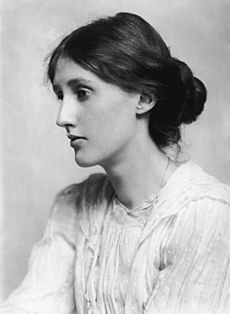
- Hylda Baker, the actress and TV comedienne, had an apartment in Ridgmount Gardens in Torrington Place, Bloomsbury, where she lived throughout the 1960s and 70s when she was in London.
- Ada Ballin (1863–1906), magazine editor and writer on fashion
- J. M. Barrie (1860–1937), playwright and novelist, lived in Guilford Street and 8 Grenville Street when he first moved to London; this is where Barrie situated the Darlings' house in Peter Pan.
- Vanessa Bell (1879–1961), painter, sister of Virginia Woolf, lived at 46 Gordon Square.
- William Copeland Borlase M.P. (1848–1899), died bankrupt and disowned by his family at 34 Bedford Court Mansions.
- Vera Brittain (1893–1970) and Winifred Holtby (1898–1935), lived at 58 Doughty Street.
- Randolph Caldecott (1846–1886), illustrator, lived at 46 Great Russell Street.
- William Cavendish, 3rd Duke of Devonshire (1698–1755), sold the Old Devonshire House at 48 Boswell Street.
- Charles Darwin (1809–1882), lived at 12 Upper Gower Street in 1839.
- George Dance (1741–1825), architect, lived at 91 Gower Street.
- Charles Dickens (1812–1870), novelist, lived at 14 Great Russell Street, Tavistock Square and 48 Doughty Street.
- George du Maurier (1834–1896), artist and writer, lived at 91 (formerly 46) Great Russell Street.
- Benton Fletcher (1866–1944), housed his keyboard collection at the Old Devonshire House, 48 Boswell Street, in the 1930s and 40s.
- E. M. Forster (1879–1970), novelist, essayist, and broadcaster, resided in Brunswick Square
- Ricky Gervais (born 1961), comedian, lived until recently in Southampton Row, Store Street and owned one of the penthouses in Bloomsbury Mansions in Russell Square, WC1.
- Mary Anne Everett Green (1818–1895), Calenderer of State Papers, author of Lives of the Princesses of England, mother of Evelyn Everett-Green, a prolific 19th-century novelist.
- Philip Hardwick (1792–1870) and Philip Charles Hardwick (1822–1892), father and son, architects, lived at 60 Russell Square for over ten years.
- Travers Humphreys (1867–1956), barrister and judge, was born in Doughty Street.
- John Maynard Keynes (1883–1946), economist, lived for 30 years in Gordon Square.
- Vladimir Lenin (1870–1924), founder of the USSR, lived here in 1908.
- James Lind of Windsor (1736–1812), natural philosopher, physician to George III
- Emanuel Litvinoff (1915–2011), author, poet, playwright and human rights campaigner, lived for 46 years in Mecklenburgh Square.
- Edmund Lodge (1756–1839), officer of arms and writer on heraldry, died at his Bloomsbury Square house on 16 January 1839.
- Bob Marley (1945–1981), musician, lived in 34 Ridgmount Gardens for six months in 1972.
- Charlotte Mew (1869–1928), poet, was born at 30 Doughty Street and lived there until the family moved nearby to 9 Gordon Street, in 1890.
- Jacquie O'Sullivan (born 1960), musician and former member of Bananarama.
- Dorothy Richardson (1873–1957), novelist, lived at 7 Endesleigh Street and 1905–6 Woburn Walk. Her experiences are recorded in her autobiographical novel, in thirteen volumes, Pilgrimage.
- Sir Francis Ronalds (1788–1873), inventor of the electric telegraph, lived at 40 Queen Square in 1820–1822.
- Dorothy L. Sayers (1893–1957), novelist lived at 24 Great James Street from 1921 to 1929. Her main female character Harriet Vane also lived in Bloomsbury.
- Alexei Sayle (born 1952), English stand-up comedian, actor and author.
- John Shaw Senior (1776–1832) and John Shaw Junior (1803–1870), father and son, architects, lived in Gower Street.
- Catherine Tate (born 1968), actress and comedian, brought up in the Brunswick Centre, close to Russell Square.
- Wee Georgie Wood (1895–1979), actor and comedian, lived and died at Gordon Mansions on Torrington Place.
- Virginia Woolf (1882–1941), author, essayist, and diarist, resided at 46 Gordon Square (1904–07) and 52 Tavistock Square (1924–39).
- Thomas Henry Wyatt (1807–1880), architect, lived at 77 Great Russell Street.
- John Wyndham (1903–1969), lived at the Penn Club in Tavistock Square (1924–38) and then (except for 1943–46 army service) at the club's present address, 21–22 Bedford Place, off Russell Square, until his marriage in 1963 to Grace Isabel Wilson, who had lived in the next room at the club.
- William Butler Yeats (1865–1939), poet, dramatist and prose writer, lived at Woburn Walk.
Images for kids
-
The Church of Christ the King was built in 1850.
-
The Main Building of University College London
See also
 In Spanish: Bloomsbury para niños
In Spanish: Bloomsbury para niños









